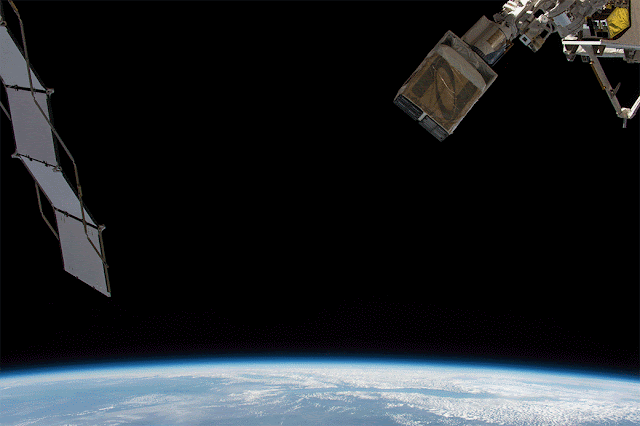MinXSS CubeSat logo.
Oct. 7, 2016
Along with the visible light and warmth constantly emitted by our sun comes a whole spectrum of X-ray and ultraviolet radiation that streams toward Earth. A new CubeSat – a miniature satellite that provides a low-cost platform for missions – is now in space observing a particular class of X-ray light that has rarely been studied.
MinXSS CubeSat Brings New Information to Study of Solar Flares
Video above: This video was made using MinXSS data from a low-intensity solar flare that occurred on July 21, 2016, from 1:33-2:23 UT, and imagery from NASA’s SDO. On the graph, pre-flare levels are shown in red, and the yellow line is the flare spectrum in real-time. MinXSS saw energy and brightness increase during the solar flare, which is apparent in the corresponding SDO images when a loop of solar material rises from an active region on the sun and shines brightly. Scientists use these flare measurements to trace the temperature, density and abundance of solar flare material during a flare. Video Credits: NASA’s Goddard Space Flight Center/LASP/MinXSS/SDO/Joy Ng, producer.
On June 9, 2016, the NASA-funded, bread loaf-sized Miniature X-Ray Solar Spectrometer, or MinXSS, CubeSat began science operations, collecting data on soft X-rays. Watch the video to see a low-intensity solar eruption – a solar flare – from July 21, 2016. The flare imagery was captured by NASA's Solar Dynamics Observatory; the MinXSS data shown on the right shows the soft X-rays observed in near-Earth space by the CubeSat before and during the flare.
Animation above: Taken by astronauts on May 16, 2016, these images show a CubeSat deployment from the International Space Station. The bottom-most CubeSat is the NASA-funded MinXSS CubeSat, built by the University of Colorado, Boulder. Image Credit: NASA.
Each type of solar radiation conveys unique information about the physics underlying solar flares. This data reveals the temperature, density and abundance of solar flare material, all critical factors for determining how flares evolve and heat the sun’s atmosphere. Ultimately, solar eruptions impact Earth’s upper atmosphere: X-rays from the sun can disturb near-Earth space, interfering with GPS, radio and other communication signals. The class of X-rays that MinXSS observes are particularly important for their influence in the level of the upper atmosphere called the ionosphere.
This video shows how dynamic the solar atmosphere can become, and highlights that MinXSS has great sensitivity to observe even the weak flares. These observations exemplify the goals of the six-month mission, which began after the spacecraft was deployed from the International Space Station in May 2016 and has already met its criteria for comprehensive success. The University of Colorado, Boulder, manages MinXSS under the direction of principal investigator Tom Woods.
Related Links:
MinXSS CubeSat Deployed From the ISS to Study Sun’s Soft X-Rays: http://www.nasa.gov/feature/goddard/2016/minxss-cubesat-deployed-from-iss-to-study-sun-s-soft-x-rays
More information on MinXSS CubeSat: http://lasp.colorado.edu/home/minxss/
More information on NASA’s CubeSats: http://www.nasa.gov/mission_pages/cubesats/index.html
Video (mentioned), Animation (mentioned), Text, Credits: NASA’s Goddard Space Flight Center, by Lina Tran/Rob Garner.
Best regards, Orbiter.ch


